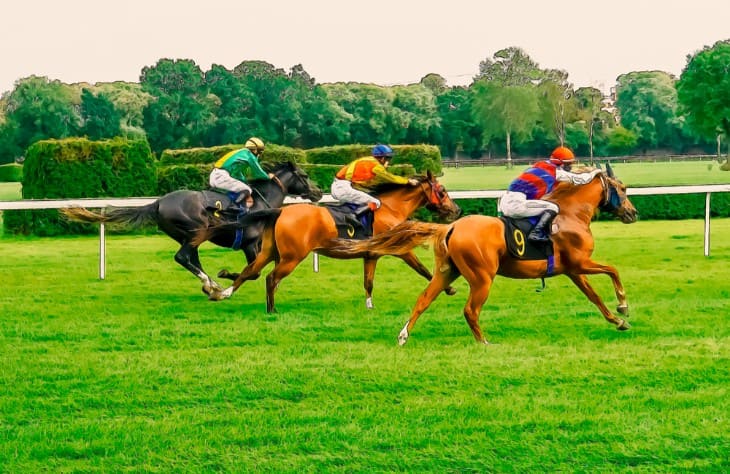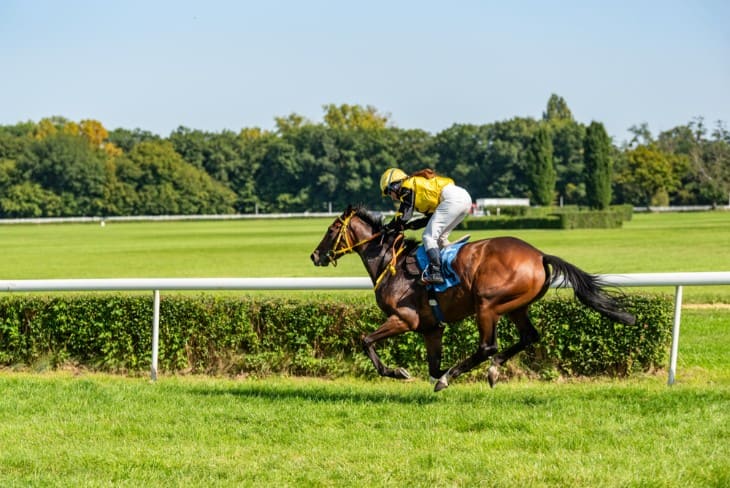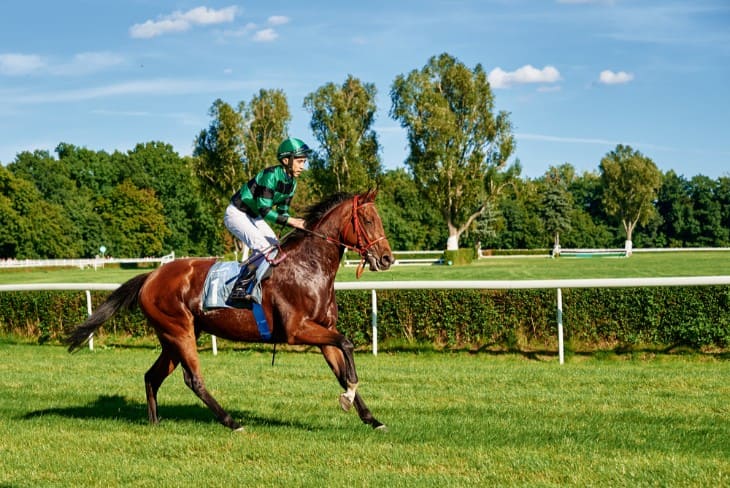- Spotting Fatigue in Horse Racing is Essential
- What Are The Signs of Fatigue in a Horse
- The Importance of Pre-Race Observations
- Analysing Past Performance & Racing Patterns
- The Impact of Race Conditions on Horse Fatigue
- The Importance of Jockey Insights and Strategies
- Using Technology to Aid in Spotting Fatigue
- Conclusion
In the dynamic universe of horse racing, spotting fatigue can be a game-changer. When you read a race and see signs of exhaustion in horses, that could mean more money in your pocket. This article will give you all the knowledge you need to spot when a horse is getting tired during a race. These little signs can help you make better choices while betting so that you increase your chances of winning.
Spotting Fatigue in Horse Racing is Essential
If there’s one thing everyone agrees on, it’s that tired horses don’t perform well. Horses are like athletes; if they’re exhausted before they start running, they’ll never win. You want to avoid horses that might be too worn out to do well in the race so that you don’t lose money on bets.
Fatigue doesn't only happen during races. There are different ways for horses to get tired and several factors are at play. For example, if a horse has already raced too much this month, it'll run slower this time—it's just common sense! By understanding these factors and watching how the horse behaves before the race starts, you can anticipate which ones may have trouble finishing strong or even winning.
While reading this article about spotting fatigue in horses, remember: that every little thing counts when it comes to betting on races. Spotting fatigue is no different from having secret knowledge about which horses are going to perform well and which ones won't. To survive in this world of gambling, focus on discovering little clues that others might have missed and use them as an advantage against competitors.
Understanding what type of shape each horse is in before choosing where to place your bet is crucial — especially if said animal has been running into the ground lately…literally! In other words, if a horse has already competed multiple times recently then it makes perfect sense why it wouldn't be able to finish strong or even win against its opponents. Fatigue is just the nail in the coffin.
What Are The Signs of Fatigue in a Horse
It helps you understand which horses are in good shape and which aren’t. It can change the outcome of a race and affect your bets
- Excessive Sweating: Horses, like humans, sweat when they exert themselves. But if you see a horse sweating more than it normally does or more than other horses do, it may be a sign that the horse is tired. Similar to how breaking into a sweat early on in a workout could mean they're having trouble keeping up.
- Ears Not Pricked Forward: If you’ve ever seen a horse in action, then you might have noticed that their ears will usually prick forward when the horse is alert and performing well. If a horse’s ears aren’t pricked forward and instead are drooping or moving sideways, this can be another sign of fatigue. It works similarly to people; when we lose focus our body language changes as well.
- Behaviour in the Paddock: Before the race begins, take some time to watch each horse. A restless or lethargic-looking horse may be indicating that it's too tired for this competition. Just like an athlete before a race; their behaviour can be very telling about whether or not they're ready.
- Response to the Jockey: During the race, pay attention to how each horse reacts to its jockey’s commands. A fatigued horse won’t respond as quickly as others and might struggle with maintaining speed. This is similar to one team player not being able to keep up with everyone else in a team sport.

The Importance of Pre-Race Observations
Observing horses before races begin is essential in this sport – especially when it comes down to figuring out if any competitors are fatigued. Think of it as doing your research before placing bets on football games; gathering information is everything.
Watching the horses while they’re still at rest in the paddock is highly beneficial for anyone interested in the outcomes of these races. Check for energy levels and signs of attentiveness here first. A horse that seems lively and alert probably feels great physically. On the other hand, if a horse doesn’t look like it has much energy or interest in competing, it might be tired or worn out. It’s similar to observing athletes warm up before they enter the field; their body language will give you a lot of hints.
Next, focus on how the horses move around during their warm-up routines. Generally speaking, a horse that is physically okay will have a very smooth and confident stride. And if they seem stiff and uneasy as they walk around; this could indicate that something is wrong with them mentally or physically (or both). Picture watching runners jog before they take off down their track; if their movements are off-putting then odds are so is their fitness level.
Take notice of how each horse interacts with its handler and everything/everyone around it as well. One horse may be easy to manage and respond well to its trainer's cues; this means that it's probably in good shape overall. A hard-to-handle horse on the other hand may have lots of trouble staying focused long enough to maybe win this race – something just isn't clicking for them right now. This scenario works similarly to tennis players who can't keep conversations with their coaches steady; you can tell from behaviour like this alone that there's likely something going on behind the scenes.
Lastly, briefly assess each horse's general appearance. Most people interested in these races can easily spot signs of good health – shiny coats and bright eyes are two examples of things we want to see when we glance at any racer here today. If one doesn't look too healthy though then don't expect them to perform very well either – think of cars that are about to race; the quality they're in has a massive effect on what will happen next.
Analysing Past Performance & Racing Patterns
Of course, studying past performances might not always guarantee success when betting money on horse racing – but it helps! The idea behind this is quite similar to getting a read on a team player's current form by looking at their past games.
To begin, inspect the horse's most recent performances. How has it fared on the track? If a horse is doing great and then starts to do bad, there might be an issue it's dealing with. Like a top athlete who suddenly can't win a game.
See how the horse finishes races. Does it start strong but end up falling in the ranks towards the end? This could mean that the horse has a stamina problem. It's like how when you run; if you give all your energy at first you'll have nothing left by the last lap.
Check out how much it races as well. A busy schedule can lead to fatigue and if a horse is racing too often that could be what's happening here. Think about if you were part of a football team that played every day for weeks straight; you’d get pretty tired too!
Look at the conditions of the races the horse has run. Long races or races on heavy tracks can be more tiring. If a horse has had a series of tough races, it might be feeling the strain. This is like an athlete who's had a string of tough competitions; they might not be at their best.
The Impact of Race Conditions on Horse Fatigue
Race conditions play a significant role in affecting a horse's performance, particularly in terms of fatigue. Various elements of the race setup can influence how much a horse tires during the event. Understanding these factors can help you make better betting decisions.
- Race Length: The distance of the race is a major factor in horse fatigue. Longer races require more stamina and can tire horses more quickly. It's like comparing a sprint to a marathon; the longer the race, the more endurance is needed.
- Track Surface: The type of surface the race is run on also affects fatigue. Soft or heavy tracks can be more challenging and tiring for horses to run on. It's similar to running on sand versus running on a track; the harder the surface, the more effort it takes.
- Weather Conditions: Weather can have a big impact on how a horse performs. Hot or humid weather can lead to quicker fatigue. This is like athletes competing in hot conditions; they get tired faster and need more energy to perform.
- Pace of the Race: The speed at which a race is run influences horse fatigue. A fast-paced race can tire horses out more quickly. It's like setting a fast pace in a long-distance run; it can lead to exhaustion sooner.
- Horse's Position in the Race: Where a horse is positioned during the race can also affect its energy levels. Being in front of constantly fighting for position can be more tiring. This is similar to a cyclist in a race; leading or constantly jostling for position uses more energy.

The Importance of Jockey Insights and Strategies
Jockey insights and strategies play a crucial role in horse racing, especially when it comes to spotting fatigue. Jockeys are the ones riding the horses, so they have first-hand knowledge of how a horse is feeling and performing. Their strategies and decisions during the race can tell you a lot about a horse's condition.
A jockey's tactics can be a big clue to a horse's energy levels. If a jockey seems to be holding a horse back or not pushing it as hard as usual, it might mean the horse is not in top form. It's like a coach changing tactics in a football match; they're adapting to the situation.
Pay attention to how the jockey and horse are working together. A good partnership means they're in sync, and the horse is responding well to the jockey's commands. If the horse seems unresponsive or the jockey is struggling to control it, the horse might be tired or not feeling its best. This is like a dance duo; if they're not in harmony, the performance suffers.
Jockeys also know how to manage a horse's energy during a race. They can decide when to speed up or slow down, which can affect how tired the horse gets. A smart jockey will pace the race to keep the horse's energy levels balanced. This is like a runner pacing themselves in a marathon; it's all about energy management.
Using Technology to Aid in Spotting Fatigue
Technology has become a valuable tool in horse race betting, especially when it comes to spotting fatigue in horses. Various technological advancements can help you get a deeper understanding of a horse's condition and performance.
One way technology helps is through detailed data analysis. There are software and apps that can analyse a horse's past races and give you insights into its performance patterns. This is like having a high-tech sports analyst who can break down a player's past games.
Biometric tracking is another area where technology is making a big impact. Some systems can track a horse's heart rate, breathing, and movement. This gives you a clearer picture of the horse's physical condition. It's similar to athletes wearing fitness trackers; you get real-time data on their physical state.
Technology can also help in monitoring a horse's training and recovery. This includes tracking how much rest a horse gets and how it's responding to training. By understanding a horse's preparation, you can better predict its performance in a race. It's like tracking a runner's training routine before a big race.
Live streaming and video analysis are other useful tools. Watching races live or reviewing past races can help you spot signs of fatigue that you might miss otherwise. It's like reviewing game footage in other sports; you can pick up on details that aren't obvious at first glance.
Conclusion
Spotting fatigue in horses is an essential skill for anyone serious about horse race betting. It requires a keen eye, an understanding of horse behaviour, and the ability to interpret a range of factors that impact a horse's performance.
By mastering this skill, you can make more informed betting decisions, potentially leading to better results. Remember, successful betting is not just about picking winners; it's about understanding every aspect of the race, including the condition of the horses involved.








